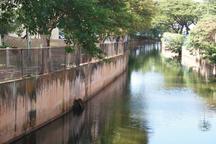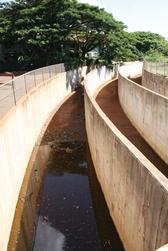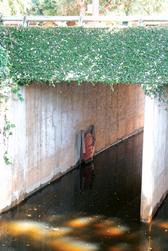During and in the days immediately following big storms, it's pretty common to see a plume of brown water fan out across the shallows from the mouth of the Honokowai Channel. The channel starts in the Honokowai Valley, way up in the West Maui Mountains, then runs to the sea, finally terminating on the northern edge of the Ka'anapali Shores Resort on the Westside.
Even on dry days, more than a few nearby locals have looked on the channel—and the big sewage treatment plant that lies just across Honoapi'ilani Highway—with suspicion and concern. Now, the results of a citizen-sponsored scientific study of the channelwaters would seem to bear those suspicions out.
"These data document exceedances of water quality criteria for bacteria, turbidity and nutrients in coastal waters at the Honkowai Stream discharge," wrote Sharyn J. Matin, president of the West Maui Preservation Association (WMPA), to the state Environmental Planning Office on Oct. 31 of this year. "We believe that the proximity of the channel to a major sewage treatment plant and the documented exceedances of bacterial water quality criteria for recreational users are evidence of a public health hazard that should be addressed expeditiously."
Water Quality Consulting, Inc.—the Kihei-based firm operated by water quality specialist Robin S. Knox—conducted WMPA's research. Called a "synoptic survey"—a look at what Knox called a "snapshot in time"—the study contains data collected between Aug. 28 and Oct. 18 of 2006. Knox said she took water samples in wet and dry times from two footbridges that span the channel—one just makai of the Lower Honoapi'ilani Road bridge over the channel, the other just mauka of the shoreline—as well as the sand berm that lies at the mouth of the channel and near shore waters about a 100 feet north and south of the channel.
According to Knox's report, the results showed "elevated" levels of Enterococcus bacteria, Clostridium and fecal Coliform bacteria—levels she said exceeded state health quality levels—as well as low levels of E. coli.
"All of these organisms are considered to be indicative of the presence of human waste and potential presence of human pathogens," Knox wrote.
 |
| The channel, as it runs towards the ocean alongside the Ka`anapali Shores resort |
In a later interview, Knox said it was hard to say precisely how the bacteria had gotten into the channel.
"There are any number of sources," Knox said. "[But] sewage is a potential source and a likely source, having the sewer lines there, the sewage plant there. There could be leaking sewer lines, septic tanks… There is a cause for concern for recreational users as well as the ecology of near-shore waters."
Matin sent Knox's report to state Director of Health Dr. Chiyome L. Fukino, but said she has yet to receive a response (a department spokesperson said she could find no record of Fukino's office receiving the study).
Roland Asakura, the Environmental Health Specialist for the county Department of Health, said he hadn't heard of any bacteria present in Honokowai Channel. So I read him some of Knox's findings.
Asakura said the Enterococcus (121 and 96 units per 100 ml, sampled at the two pedestrian bridges spanning the channel) was probably naturally occuring, since the bacteria lives in Hawai'i's soil. The Clostridium (18 and 17 units per 100 ml, at the same two sits) was possibly due to the presence of stagnant water and "probably not indicative of sewage," since their concentrations were relatively low.
As for the presence of fecal Coliform (greater than 1,600 units per 100 ml at the two sample sits), Asakura had no explanation.
In June 2006, Matin took me on a brief tour of the Honokowai Channel. Knox still had a couple months before she'd be ready to start taking samples, but Matin was willing to outline the study as long as I'd promise not to publish a story before the research was complete.
In the waters immediately on either side of the channel mouth, kids played in the shallows. The channel itself terminated just shy of a low berm lying on the sand, but during heavy rains, water was known to flow over the sand, directly into the ocean.
 |
| The channel mauka of Lower Honoapi`ilani Road |
Just a few yards mauka of the beach, a small footbridge connected the Ka'anapali Shores beach path with the private condos on the other side of the channel. Near the footbridge, there were even a few stone benches and a trashcan for guests wanting a "riverwalk" scene to smoke, though the water in the channel was low, dark and rather murky.
A few minutes upstream, where the channel diverts into three concrete spillways that run underneath Lower Honoapi'ilani Road, Matin and I walked across a second footbridge. The channel is pretty dark as it runs beneath the road, but from the middle of the footbridge, we could see two manhole-size metal doors on either side of the channel that clearly led into the sewer system. Both doors were closed that day—and on a return visit I took a week ago.
Matin has been interested in the quality of water flowing through Honokowai Channel since 2004, when she and other West Maui residents organized WMPA. Advocating smart growth and better urban planning and funded by private donations, WMPA has, through lawsuits and settlement agreements, managed to force a few concessions on big developers, like traffic impact fees from Starwood Vacation Homes on Northbeach and a private sewage treatment plant for the big Pulelehua project from the Maui Land & Pineapple Co.
At first, WMPA members just tracked West Maui sewage spills—58,000 gallons in March 2004, 18,000 gallons in October 2006 and so on. On March 30, 2006, a 12-inch sewer line burst on Front Street, spilling 3,125 gallons of sewage.
Just six days later, county public works officials begged the Maui County Council Budget Committee for $25.9 million in new sewer projects. "We just can't afford not to replace these things before they break," Wastewater Reclamation Division Chief David Taylor told the committee.
In all, WMPA spent thousands of dollars on Knox's research, all of it raised privately. Research of this kind—meeting U.S. Environmental Protection Agency standards—isn't cheap or easy.
Making matters worse was the fact that there are no commercial labs capable of testing for bacteria on Maui. That meant flying the samples—packed with ice—to Honolulu. Since bacteria samples from Honokowai had to reach the lab on Oahu within six hours of being taken, and often the only airport available at short notice was in Kahului, sample-gathering was a race against the clock.
What's more, Knox had to fly the first samples to Oahu herself since her "Known Shipper Clearance" hadn't yet been processed (since 9/11, the airlines take a dim view of transporting fluids without an accompanying passenger).
Knox said she's spent 25 years working on issues related to the federal Clean Water Act. In fact, she moved to Maui in 2005 specifically to work on water quality issues (earlier this year, after controversy erupted over her relatively brief time on the island, Knox withdrew her name from consideration for a seat on the Maui Planning Commission, saying she couldn't adequately balance both the commission and her work for Water Quality Consulting).
Matin wasn't surprised by the results of the synoptic survey, but Knox was. "I was surprised at the high level of pathogenic indicators," she said. "In the data I've seen, I was surprised at the levels of bacteria."
In an interview, Knox elaborated on the bacteria results.
 |
| The channel as runs beneath Lower Honoapi`ilani Road |
"The Enterococcus is controversial," she said, adding that though the federal EPA says the presence of Enterococcus bacteria is a good indicator of sewage, there is a strong feeling, as Asakura of the county's Department of Health noted, that in Hawai'i that there's a good deal of the bacteria naturally living in the soil.
But Knox said her samples also showed excessive levels of fecal Coliform and Clostridium—bacteria that she said is nearly always present in sewage.
Still, Knox cautioned that much more testing needs to happen, saying that her data only indicates "concentration" of certain pollutants—not duration or frequency. She said her data doesn't show any trend in the bacterial contamination of the channel—whether it's getting better or worse—but only that it was there during the time in which she tested.
Her study's conclusions and recommendations are, nonetheless, rather chilling.
"High bacteria levels pose a concern for public health, especially after rainfall events sufficient to cause a discharge from the channel to coastal waters," she wrote. "Further monitoring of the Channel and near shore waters impacted by the channel discharges is recommended." MTW


